Hello friends! Its that time again! This is the latest I have started a grow thread, usually I start them in late April/Early May, but Spring took its time getting started this year, and a few set backs also delayed my season. But I am for sure in for the long haul this year!
I'm sorry I have not been around, about the time I planted my 4th plant this spring I found out one of my children has a very serious condition. After this was found out, most of my free time has been taken traveling to many doctors, usually to hear bad news. I barely had time to drop in and water those few plants, much more have been waiting to go out, getting root bound in the process, but I am determined to get it done.
The prognosis looks much better for my child, and I can't get into what it is, but those of you with children will understand.
---------------------------------------------------------------------------
For those who don't know me and the region I grow in, a brief but detailed explaination:
I live in the south-west quarter of the fine state of Oregon. Although my state is usually considered a part of the Pacific north-west, my region of the state is nothing like stereotypical PNW often envisioned by outsiders. Often the PNW is portrayed as perpetually foggy, cloudy, and rainy, and covered with tall trees and moss, this vision may be half true for Seattle, and perhaps 1/4 true for Portland and the rest of North-west Oregon, but over half my state is actually bone dry desert, and the south-western portion were I live resembles the Northern California wine country much more than western Washington or NW Oregon.
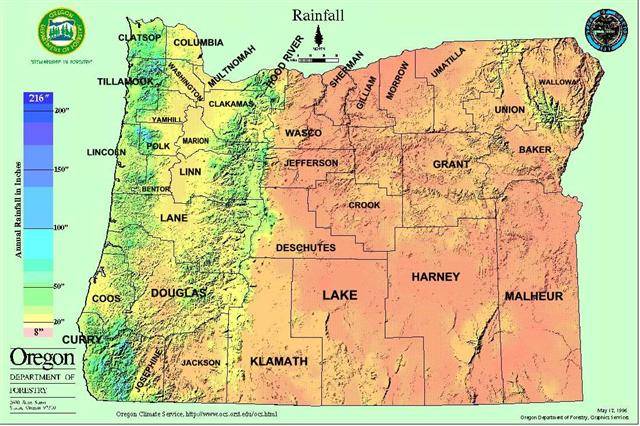
I get 18.86" total rainfall in a average year, compare that to 19.70" for San Francisco, 36.30" for Portland, and 37.19" for Seattle! As you can see, SW Oregon is not your typical wet PNW climate.
Other than big brother, my main enemy is my extremely dry summer climate, my average rainfall for May-Sept is 3.5", very dry! Compare it to Tuscon, Arizona with 6.61"" and Albuquerque, New Mexico with 5.1"! My humidity is also quite low, so my plants dry out even faster than in more humid climates, high humidity bad for humans, low humidity bad for underwatered plants.
Ever since the start of my Guerrilla growing years ago, I have struggled against the need to be constantly supplying water to my plants, typically once or twice a week from June-mid Sept. This has inspired me to find ways to use the water more efficiently, make it easier to get on site, and if possible...to find ways to reduce the need for such frequent visits, which puts me at greater risk of getting caught.
I typically grow enough plants for myself and other family members who smoke, this year I was going to go bigger, but now after set backs I am just trying to fill my personal jars.
I have decided to go Organic only from now on, not a drop of Miracle grow or Osmocote! Its not so much because they don't work(cuz they did), its just that I have always been all organic in my vegetable garden, and I no longer see the advantages of using the chems with Cannabis. I was also using those as a example for newer outdoor growers looking for a cheap and easy route, as I have always tried to make growing Bud more important than how it was grown. Its just a personal decision to finally go all organic.
Irrigation test
One of my goals for the season was to try several different irrigation systems, as a test and example of using them, for my benefit and anyone else interested. At the end of the season, it was my intent to pick one or two methods to base all my future grows on.
My original line up was going to consist of some timer based "drip" systems, some Blumats(a German made, high efficiency, self activating drip system), and my Earth hole invention.
The first problem with my plan was the Blumats, I had a hard time finding a US source of them that seemed reputable, so I gave up on them for this year.
My preseason disaster
The second problem involved a bear . In late March I found a great location in the higher elevation ridges a ways further out from where I normally plant. I had found what appeared to be a year round source of water. I had located the spot while scanning a valley from a ridge top a half mile away, I noticed a local water loving specie of tree called Red Alder, these trees need lots of ground water and act like sign saying WATER HERE, especially in these dry hills. A trip in confirmed there was indeed water.
. In late March I found a great location in the higher elevation ridges a ways further out from where I normally plant. I had found what appeared to be a year round source of water. I had located the spot while scanning a valley from a ridge top a half mile away, I noticed a local water loving specie of tree called Red Alder, these trees need lots of ground water and act like sign saying WATER HERE, especially in these dry hills. A trip in confirmed there was indeed water.
I proceeded to haul in 3 huge loads of soil amendments, water reservoirs, and 400' of 1/2" poly pipe to siphon the water from the water source to a south facing hillside nearby. After parts of 2 days, I managed to get the reservoirs filled, and the pipe hauled out. I left my soil amendments well hidden for my next visit.
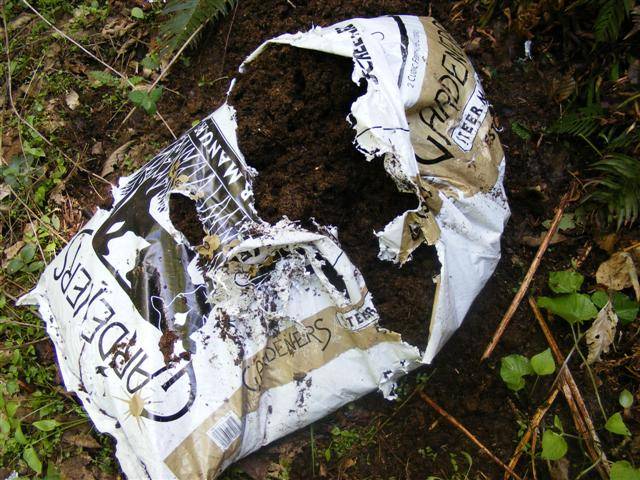
In two weeks I returned to the spot with 4 nice OR95 females, and found that my rough tote reservoirs had their lids torn off, the water fowled with dirt and rotten wood, and all my soil amendments were dug out, and a large hole dug in all the bags, even the Soft rock Phosphate and Dolomite. I had no Blood, Bone, or Fish meals, only Manures, Kelp meal, and other things that no large animal should find interesting.
The only thing I could figure was that this was a garbage bear, relocated from a more populated area, to this remote area. I have bears in the areas where I normally grow, but I have never had one interfere with a grow! Only thing I could figure was this guy was only interested in my stuff cuz he was used to exploring anything left by a human.
I repacked my plants, and hiked out to the pick up point a mile away, and wrote off what would have been my largest producing plot. I certainly couldn't conduct my grow with a bear constantly destroying it.
---------------------------------------------------------------------------
So I have settled on testing one of my Earth holes, and a few plants will be grown using "Pitcher irrigation", which consists of Terracotta planters with the drain holes plugged being placed in the ground next to the plants. The Terracotta pots sweat the water out to the soil as the soil drys, if this works, I could develop a irrigation system based on it that runs on its own for weeks.
Now on to the season...........
I have 4 plants out right now, all OR95(my personal strain). One is in a Earthhole, the other 3 are planted using pitcher irrigation.
Here is OR95 #3- Planted May 20, 2009
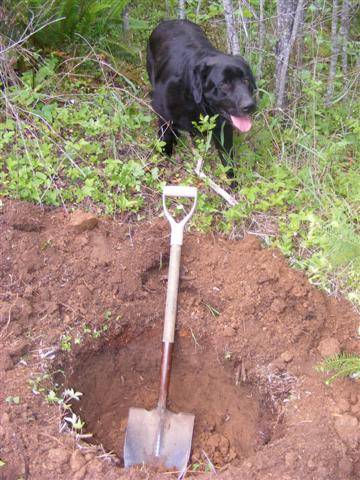
I started by digging a big hole with my D-handle shovel, the hole is 1.5' deep, by 1.5' wide.
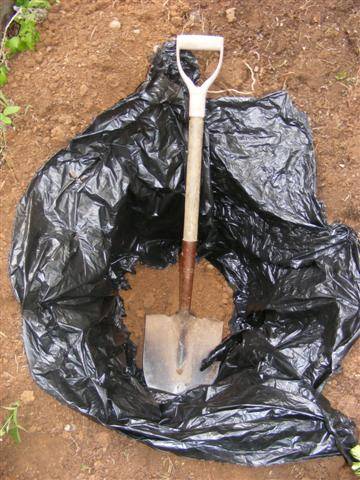
I used some large garbage bags to line the sides of the hole prior to refilling, but not the bottom. This will help block the water I provide from being stolen by native plants and soils nearby.
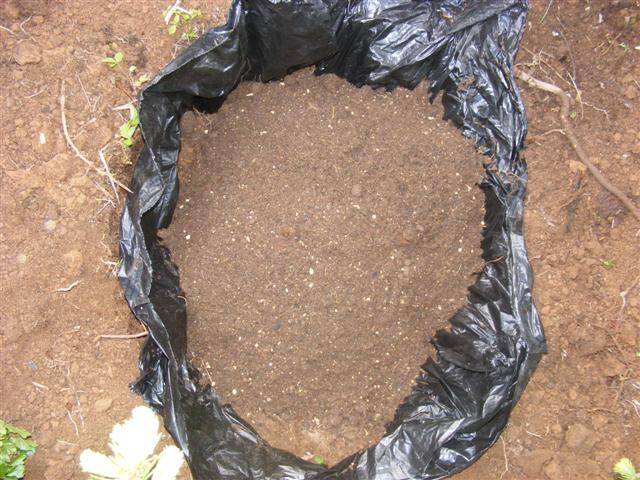
I poured in a mixture that was mostly steer manure compost, with some Chicken manure, Kelp meal, Rock phosphate, and Dolomite lime.
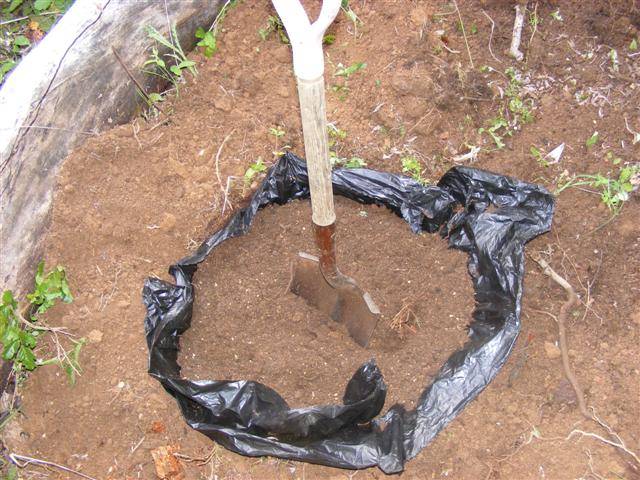
I then mixed back in enough native soil to bring the soil level back up to native.
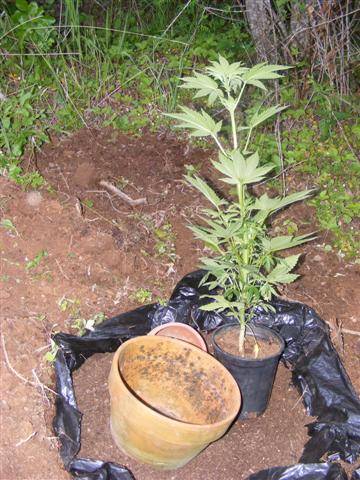
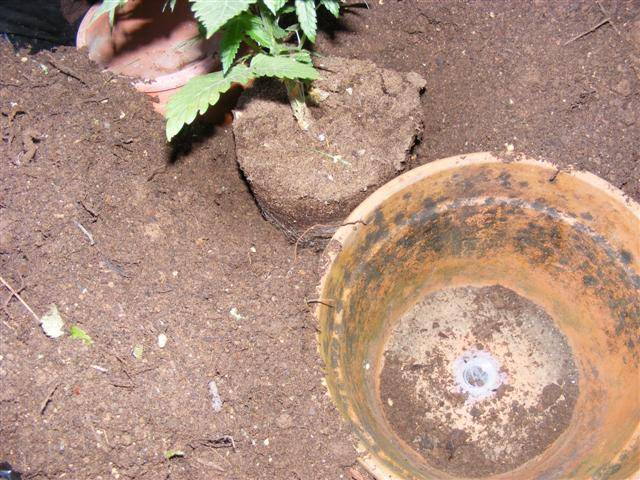
The plant and Terracotta pots being placed in the hole. The Terracotta pots have their drain holes plugged, and will sweat water into the soil as the plants need it.
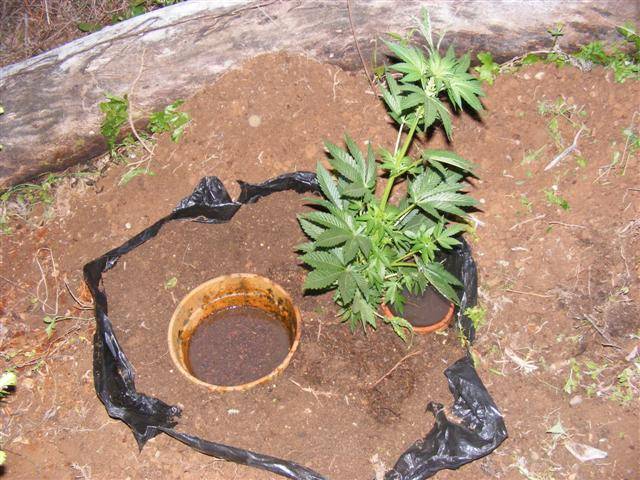
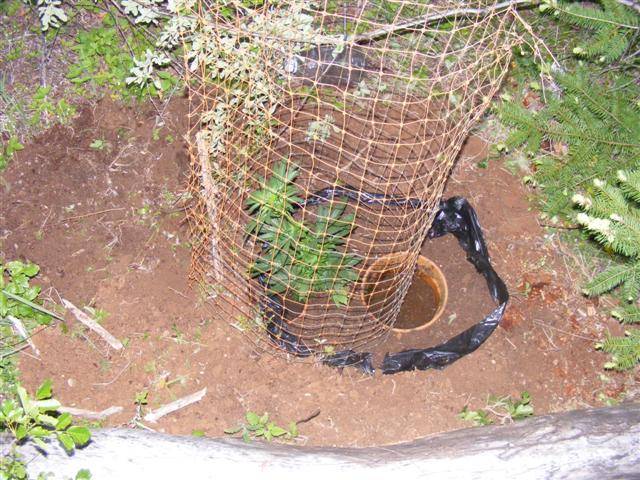
And here is the plot all set up.
OR95 #3, May 28, 2009
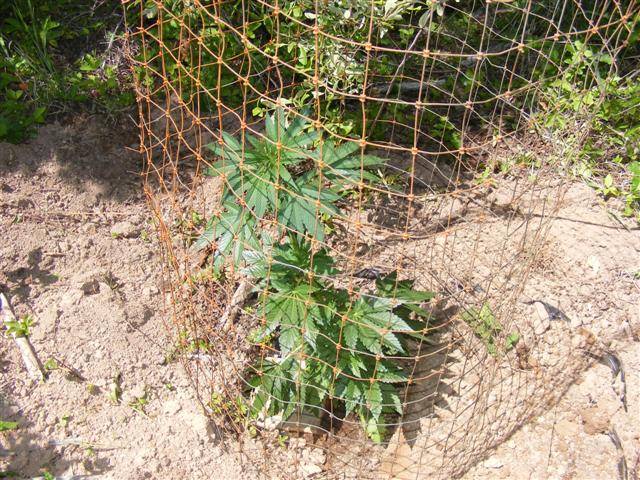
OR96 #3, June 25, 2009
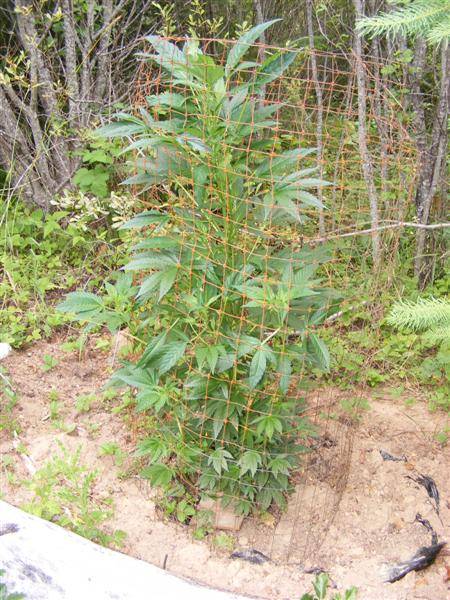
OR95 #3, July 2, 2009
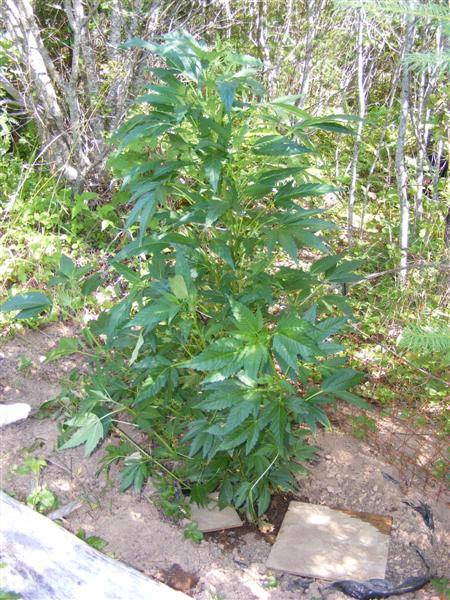
Here are the other two OR95s, also planted in the same fashion-
OR95 #1, May 20, 2009
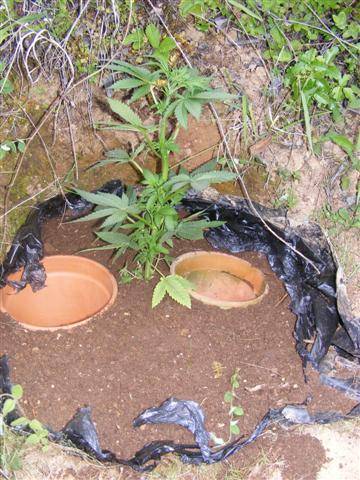
OR95 #1, May 28, 2009
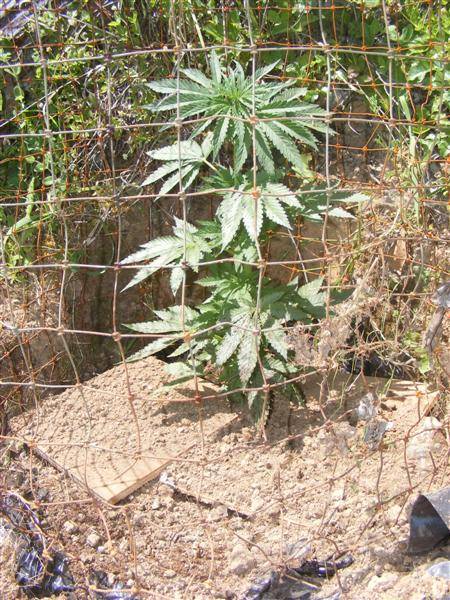
OR95 #1, June 25, 2009
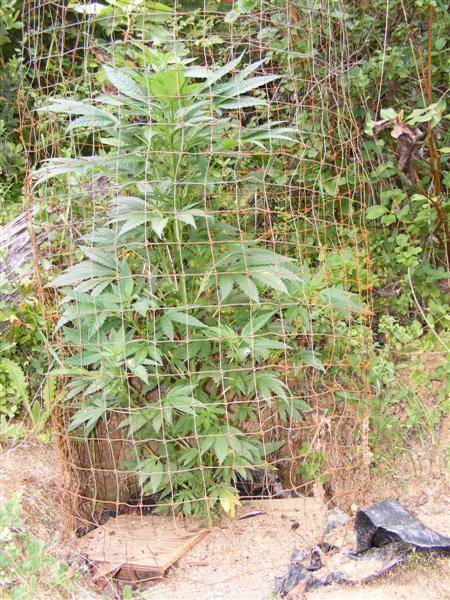
OR95 #1, July 1, 2009
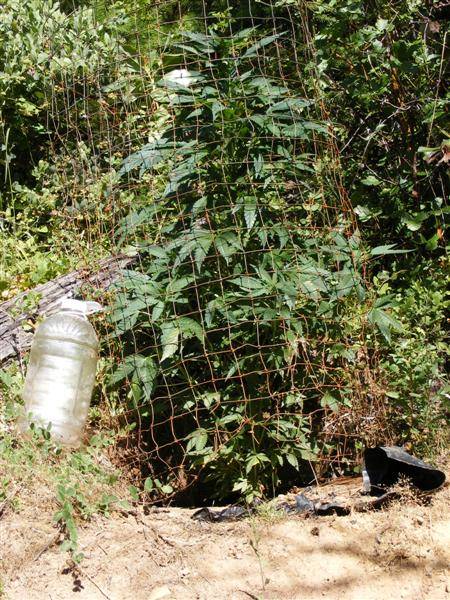
OR95 #2, May 20, 2009
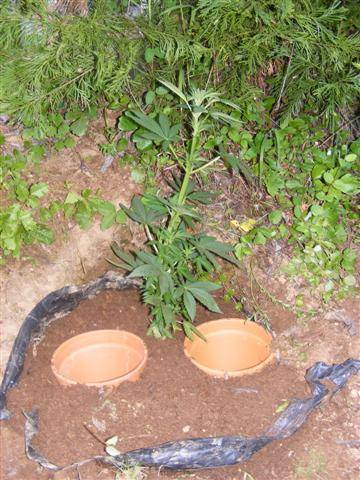
OR95 #2, May 28, 2009
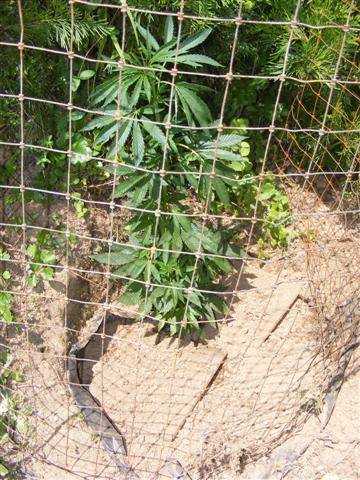
OR95 #2, June 25, 2009
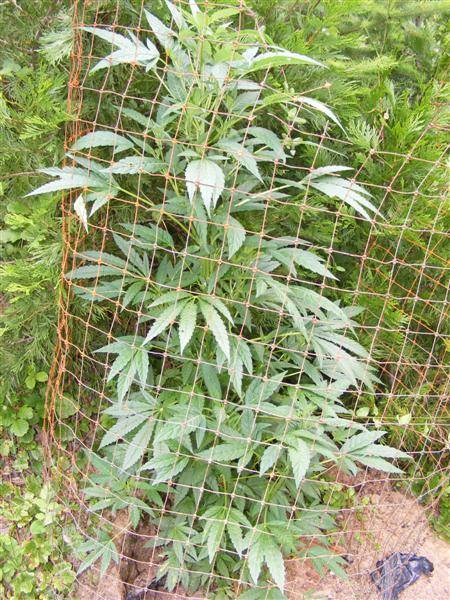
OR95 #2, July 2, 2009
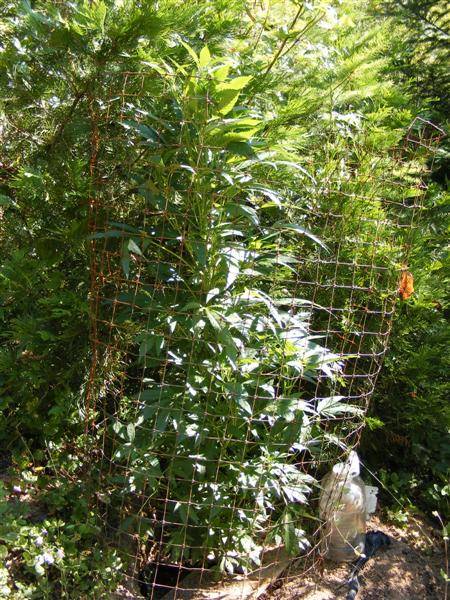
I'm sorry I have not been around, about the time I planted my 4th plant this spring I found out one of my children has a very serious condition. After this was found out, most of my free time has been taken traveling to many doctors, usually to hear bad news. I barely had time to drop in and water those few plants, much more have been waiting to go out, getting root bound in the process, but I am determined to get it done.
The prognosis looks much better for my child, and I can't get into what it is, but those of you with children will understand.
---------------------------------------------------------------------------
For those who don't know me and the region I grow in, a brief but detailed explaination:
I live in the south-west quarter of the fine state of Oregon. Although my state is usually considered a part of the Pacific north-west, my region of the state is nothing like stereotypical PNW often envisioned by outsiders. Often the PNW is portrayed as perpetually foggy, cloudy, and rainy, and covered with tall trees and moss, this vision may be half true for Seattle, and perhaps 1/4 true for Portland and the rest of North-west Oregon, but over half my state is actually bone dry desert, and the south-western portion were I live resembles the Northern California wine country much more than western Washington or NW Oregon.
I get 18.86" total rainfall in a average year, compare that to 19.70" for San Francisco, 36.30" for Portland, and 37.19" for Seattle! As you can see, SW Oregon is not your typical wet PNW climate.
Other than big brother, my main enemy is my extremely dry summer climate, my average rainfall for May-Sept is 3.5", very dry! Compare it to Tuscon, Arizona with 6.61"" and Albuquerque, New Mexico with 5.1"! My humidity is also quite low, so my plants dry out even faster than in more humid climates, high humidity bad for humans, low humidity bad for underwatered plants.
Ever since the start of my Guerrilla growing years ago, I have struggled against the need to be constantly supplying water to my plants, typically once or twice a week from June-mid Sept. This has inspired me to find ways to use the water more efficiently, make it easier to get on site, and if possible...to find ways to reduce the need for such frequent visits, which puts me at greater risk of getting caught.
I typically grow enough plants for myself and other family members who smoke, this year I was going to go bigger, but now after set backs I am just trying to fill my personal jars.
I have decided to go Organic only from now on, not a drop of Miracle grow or Osmocote! Its not so much because they don't work(cuz they did), its just that I have always been all organic in my vegetable garden, and I no longer see the advantages of using the chems with Cannabis. I was also using those as a example for newer outdoor growers looking for a cheap and easy route, as I have always tried to make growing Bud more important than how it was grown. Its just a personal decision to finally go all organic.
Irrigation test
One of my goals for the season was to try several different irrigation systems, as a test and example of using them, for my benefit and anyone else interested. At the end of the season, it was my intent to pick one or two methods to base all my future grows on.
My original line up was going to consist of some timer based "drip" systems, some Blumats(a German made, high efficiency, self activating drip system), and my Earth hole invention.
The first problem with my plan was the Blumats, I had a hard time finding a US source of them that seemed reputable, so I gave up on them for this year.
My preseason disaster
The second problem involved a bear
 . In late March I found a great location in the higher elevation ridges a ways further out from where I normally plant. I had found what appeared to be a year round source of water. I had located the spot while scanning a valley from a ridge top a half mile away, I noticed a local water loving specie of tree called Red Alder, these trees need lots of ground water and act like sign saying WATER HERE, especially in these dry hills. A trip in confirmed there was indeed water.
. In late March I found a great location in the higher elevation ridges a ways further out from where I normally plant. I had found what appeared to be a year round source of water. I had located the spot while scanning a valley from a ridge top a half mile away, I noticed a local water loving specie of tree called Red Alder, these trees need lots of ground water and act like sign saying WATER HERE, especially in these dry hills. A trip in confirmed there was indeed water.I proceeded to haul in 3 huge loads of soil amendments, water reservoirs, and 400' of 1/2" poly pipe to siphon the water from the water source to a south facing hillside nearby. After parts of 2 days, I managed to get the reservoirs filled, and the pipe hauled out. I left my soil amendments well hidden for my next visit.
In two weeks I returned to the spot with 4 nice OR95 females, and found that my rough tote reservoirs had their lids torn off, the water fowled with dirt and rotten wood, and all my soil amendments were dug out, and a large hole dug in all the bags, even the Soft rock Phosphate and Dolomite. I had no Blood, Bone, or Fish meals, only Manures, Kelp meal, and other things that no large animal should find interesting.
The only thing I could figure was that this was a garbage bear, relocated from a more populated area, to this remote area. I have bears in the areas where I normally grow, but I have never had one interfere with a grow! Only thing I could figure was this guy was only interested in my stuff cuz he was used to exploring anything left by a human.
I repacked my plants, and hiked out to the pick up point a mile away, and wrote off what would have been my largest producing plot. I certainly couldn't conduct my grow with a bear constantly destroying it.
---------------------------------------------------------------------------
So I have settled on testing one of my Earth holes, and a few plants will be grown using "Pitcher irrigation", which consists of Terracotta planters with the drain holes plugged being placed in the ground next to the plants. The Terracotta pots sweat the water out to the soil as the soil drys, if this works, I could develop a irrigation system based on it that runs on its own for weeks.
Now on to the season...........
I have 4 plants out right now, all OR95(my personal strain). One is in a Earthhole, the other 3 are planted using pitcher irrigation.
Here is OR95 #3- Planted May 20, 2009
I started by digging a big hole with my D-handle shovel, the hole is 1.5' deep, by 1.5' wide.
I used some large garbage bags to line the sides of the hole prior to refilling, but not the bottom. This will help block the water I provide from being stolen by native plants and soils nearby.
I poured in a mixture that was mostly steer manure compost, with some Chicken manure, Kelp meal, Rock phosphate, and Dolomite lime.
I then mixed back in enough native soil to bring the soil level back up to native.
The plant and Terracotta pots being placed in the hole. The Terracotta pots have their drain holes plugged, and will sweat water into the soil as the plants need it.
And here is the plot all set up.
OR95 #3, May 28, 2009
OR96 #3, June 25, 2009
OR95 #3, July 2, 2009
Here are the other two OR95s, also planted in the same fashion-
OR95 #1, May 20, 2009
OR95 #1, May 28, 2009
OR95 #1, June 25, 2009
OR95 #1, July 1, 2009
OR95 #2, May 20, 2009
OR95 #2, May 28, 2009
OR95 #2, June 25, 2009
OR95 #2, July 2, 2009
Last edited:

 way to go backcountry!
way to go backcountry! 




